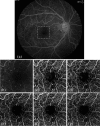Methods and algorithms for optical coherence tomography-based angiography: a review and comparison
- PMID: 26473588
- PMCID: PMC4881033
- DOI: 10.1117/1.JBO.20.10.100901
Methods and algorithms for optical coherence tomography-based angiography: a review and comparison
Abstract
Optical coherence tomography (OCT)-based angiography is increasingly becoming a clinically useful and important imaging technique due to its ability to provide volumetric microvascular networks innervating tissue beds in vivo without a need for exogenous contrast agent. Numerous OCT angiography algorithms have recently been proposed for the purpose of contrasting microvascular networks. A general literature review is provided on the recent progress of OCT angiography methods and algorithms. The basic physics and mathematics behind each method together with its contrast mechanism are described. Potential directions for future technical development of OCT based angiography is then briefly discussed. Finally, by the use of clinical data captured from normal and pathological subjects, the imaging performance of vascular networks delivered by the most recently reported algorithms is evaluated and compared, including optical microangiography, speckle variance,phase variance, split-spectrum amplitude decorrelation angiography, and correlation mapping. It is found that the method that utilizes complex OCT signal to contrast retinal blood flow delivers the best performance among all the algorithms in terms of image contrast and vessel connectivity. The purpose of this review is to help readers understand and select appropriate OCT angiography algorithm for use in specific applications.
Figures






References
-
- Bouma B., Tearney G., Handbook of Optical Coherence Tomography, Taylor & Francis, New York: (2001).
-
- Drexler W., Fujimoto J. G., Optical Coherence Tomography: Technology and Applications, Springer Publishing, Berlin, Heidelberg: (2008).
-
- Tomolins P. H., Wang R. K., “Theory, developments and applications of optical coherence tomography,” J. Phys. D: Appl. Phys. 38(15), 2519–2535 (2005).JPAPBE10.1088/0022-3727/38/15/002 - DOI

